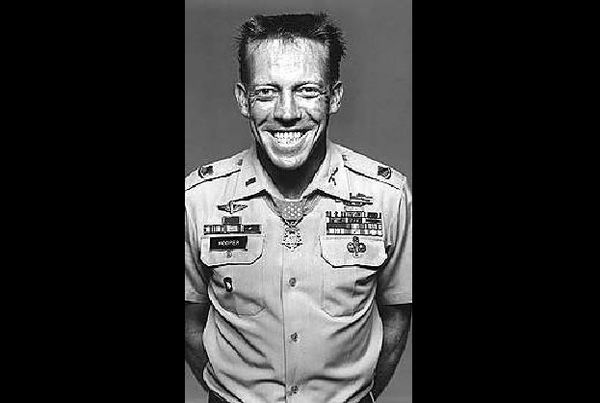a decorated hero
Sep 5, 2020 15:09:29 #
Originally a Navy man, Hooper first enlisted in December of 1956. He worked in naval aviation, eventually reaching the rank of Petty Officer 3rd class, the equivalent of an Army or Marine corporal (E-4). He was honorably discharged in 1959.
The next year, Hooper enlisted in the US Army as a Private First Class. After graduating Basic Training, he volunteered for Airborne School. From there he did tours of duty in Fort Bragg, Korea and Fort Hood, eventually making his way to Fort Campbell’s 101st Airborne Division.
Now a Staff Sergeant, Hooper requested a tour in Vietnam but was sent to Panama instead as a platoon sergeant. Unable to stay out of trouble while he was there, he was the subject of several Article 15 hearings and was eventually demoted to Corporal. However, he eventually got his Sergeant back and deployed with the 101st to Vietnam in December of 1967, taking on the role of a squad leader.
On February 21st, 1968, Hooper and his company were beginning an assault on an enemy position when they came under fire by everything from machine guns to rockets.
According to his Medal of Honor citation, Hooper’s unit “was assaulting a heavily defended enemy position along a river bank when it encountered a withering hail of fire from rockets, machine guns and automatic weapons. Staff Sergeant Hooper rallied several men and stormed across the river, overrunning several bunkers on the opposite shore.
Thus inspired, the rest of the company moved to the attack. With utter disregard for his own safety, he moved out under the intense fire again and pulled back the wounded, moving them to safety. During this act Hooper was seriously wounded, but he refused medical aid and returned to his men. With the relentless enemy fire disrupting the attack, he single-handedly stormed 3 enemy bunkers, destroying them with hand grenade and rifle fire, and shot 2 enemy soldiers who had attacked and wounded the Chaplain.
Leading his men forward in a sweep of the area, Hooper destroyed three buildings housing enemy riflemen. At this point he was attacked by a North Vietnamese officer whom he fatally wounded with his bayonet. Finding his men under heavy fire from a house to the front, he proceeded alone to the building, killing its occupants with rifle fire and grenades. By now his initial body wound had been compounded by grenade fragments, yet despite the multiple wounds and loss of blood, he continued to lead his men against the intense enemy fire.
As his squad reached the final line of enemy resistance, it received devastating fire from four bunkers in line on its left flank. Hooper gathered several hand grenades and raced down a small trench which ran the length of the bunker line, tossing grenades into each bunker as he passed by, killing all but two of the occupants.
With these positions destroyed, he concentrated on the last bunkers facing his men, destroying the first with an incendiary grenade and neutralizing two more by rifle fire. He then raced across an open field, still under enemy fire, to rescue a wounded man who was trapped in a trench. Upon reaching the man, he was faced by an armed enemy soldier whom he killed with a pistol. Moving his comrade to safety and returning to his men, he neutralized the final pocket of enemy resistance by fatally wounding three North Vietnamese officers with rifle fire. Hooper then established a final line and reorganized his men, not accepting (medical) treatment until this was accomplished and not consenting to evacuation until the following morning.”
While he was discharged from the Infantry upon his return from Vietnam in 1968, he managed to re-enlist and serve as a Public Affairs specialist until President Richard Nixon awarded him the Congressional Medal of Honor in 1969.
Hooper eventually managed to finagle his way back into the Infantry, serving a second tour in Vietnam as a pathfinder with the 101st Airborne. By 1970, he had been commissioned as a 2nd Lieutenant, though he was discharged from an active commission shortly after due to inadequate educational requirements.
Discharged and a little sour about it, Hooper managed to retain his commission in the Army Reserve’s 12th Special Forces Group before being transferred to a training unit. Though he was eventually promoted to Captain, he was discharged a final time in 1978 after a spotty drill record.
Much like the war he fought in, Hooper is not as well known as other Medal of Honor recipients of his stature. According to accounts, he was a likeable guy who partied hard, drank a lot and related to veterans. However, he was allegedly rather troubled by America’s treatment of soldiers and attitudes towards the war in general.
He was found dead in a hotel room in Kentucky on May 5, 1979, having suffered a cerebral hemorrhage in his sleep. He was 40 years old.
In addition to the Medal of Honor, Hooper was also awarded two Silver Stars, 6 Bronze Stars with “V” Devices, an Air Medal, the Republic of Vietnam Gallantry Cross with Palm and 8 Purple Hearts.
The next year, Hooper enlisted in the US Army as a Private First Class. After graduating Basic Training, he volunteered for Airborne School. From there he did tours of duty in Fort Bragg, Korea and Fort Hood, eventually making his way to Fort Campbell’s 101st Airborne Division.
Now a Staff Sergeant, Hooper requested a tour in Vietnam but was sent to Panama instead as a platoon sergeant. Unable to stay out of trouble while he was there, he was the subject of several Article 15 hearings and was eventually demoted to Corporal. However, he eventually got his Sergeant back and deployed with the 101st to Vietnam in December of 1967, taking on the role of a squad leader.
On February 21st, 1968, Hooper and his company were beginning an assault on an enemy position when they came under fire by everything from machine guns to rockets.
According to his Medal of Honor citation, Hooper’s unit “was assaulting a heavily defended enemy position along a river bank when it encountered a withering hail of fire from rockets, machine guns and automatic weapons. Staff Sergeant Hooper rallied several men and stormed across the river, overrunning several bunkers on the opposite shore.
Thus inspired, the rest of the company moved to the attack. With utter disregard for his own safety, he moved out under the intense fire again and pulled back the wounded, moving them to safety. During this act Hooper was seriously wounded, but he refused medical aid and returned to his men. With the relentless enemy fire disrupting the attack, he single-handedly stormed 3 enemy bunkers, destroying them with hand grenade and rifle fire, and shot 2 enemy soldiers who had attacked and wounded the Chaplain.
Leading his men forward in a sweep of the area, Hooper destroyed three buildings housing enemy riflemen. At this point he was attacked by a North Vietnamese officer whom he fatally wounded with his bayonet. Finding his men under heavy fire from a house to the front, he proceeded alone to the building, killing its occupants with rifle fire and grenades. By now his initial body wound had been compounded by grenade fragments, yet despite the multiple wounds and loss of blood, he continued to lead his men against the intense enemy fire.
As his squad reached the final line of enemy resistance, it received devastating fire from four bunkers in line on its left flank. Hooper gathered several hand grenades and raced down a small trench which ran the length of the bunker line, tossing grenades into each bunker as he passed by, killing all but two of the occupants.
With these positions destroyed, he concentrated on the last bunkers facing his men, destroying the first with an incendiary grenade and neutralizing two more by rifle fire. He then raced across an open field, still under enemy fire, to rescue a wounded man who was trapped in a trench. Upon reaching the man, he was faced by an armed enemy soldier whom he killed with a pistol. Moving his comrade to safety and returning to his men, he neutralized the final pocket of enemy resistance by fatally wounding three North Vietnamese officers with rifle fire. Hooper then established a final line and reorganized his men, not accepting (medical) treatment until this was accomplished and not consenting to evacuation until the following morning.”
While he was discharged from the Infantry upon his return from Vietnam in 1968, he managed to re-enlist and serve as a Public Affairs specialist until President Richard Nixon awarded him the Congressional Medal of Honor in 1969.
Hooper eventually managed to finagle his way back into the Infantry, serving a second tour in Vietnam as a pathfinder with the 101st Airborne. By 1970, he had been commissioned as a 2nd Lieutenant, though he was discharged from an active commission shortly after due to inadequate educational requirements.
Discharged and a little sour about it, Hooper managed to retain his commission in the Army Reserve’s 12th Special Forces Group before being transferred to a training unit. Though he was eventually promoted to Captain, he was discharged a final time in 1978 after a spotty drill record.
Much like the war he fought in, Hooper is not as well known as other Medal of Honor recipients of his stature. According to accounts, he was a likeable guy who partied hard, drank a lot and related to veterans. However, he was allegedly rather troubled by America’s treatment of soldiers and attitudes towards the war in general.
He was found dead in a hotel room in Kentucky on May 5, 1979, having suffered a cerebral hemorrhage in his sleep. He was 40 years old.
In addition to the Medal of Honor, Hooper was also awarded two Silver Stars, 6 Bronze Stars with “V” Devices, an Air Medal, the Republic of Vietnam Gallantry Cross with Palm and 8 Purple Hearts.

Sep 5, 2020 15:22:16 #
Thanks for that BB. I continue to be amazed and grateful for the bravery of those who served and those who continue to do so.
Sep 5, 2020 15:49:06 #
FourchonLa. wrote:
Thanks for that BB. I continue to be amazed and grateful for the bravery of those who served and those who continue to do so.
most everyone loves a hero
Sep 5, 2020 16:08:21 #
I guess it depends on how you define "hero"? There are those who don't get why a guy like this would do what he did, and would consider him loser. Like one of my heroes, John McCain, who said "I'm not a hero. But the great honor of my life was to serve in the company of heroes"
Not trying to hijack your post bobby, but yesterday was a gut punch. I'm not at a loss for words, but I'm not gonna go there right now.
Not trying to hijack your post bobby, but yesterday was a gut punch. I'm not at a loss for words, but I'm not gonna go there right now.
Sep 5, 2020 16:44:54 #
badbobby wrote:
Originally a Navy man, Hooper first enlisted in De... (show quote)
Thanks bb he looks like he would also be one to enjoy life to its fullest.
Sep 5, 2020 17:02:01 #
Spiritof27 wrote:
I guess it depends on how you define "hero"? There are those who don't get why a guy like this would do what he did, and would consider him loser. Like one of my heroes, John McCain, who said "I'm not a hero. But the great honor of my life was to serve in the company of heroes"
Not trying to hijack your post bobby, but yesterday was a gut punch. I'm not at a loss for words, but I'm not gonna go there right now.
Not trying to hijack your post bobby, but yesterday was a gut punch. I'm not at a loss for words, but I'm not gonna go there right now.
hope it wasn't me that punched you Spirit
Sep 5, 2020 17:03:09 #
Sep 5, 2020 17:04:48 #
if you don't watch the news you are blessed - I'm gonna stop too I think, at least until after January next year, then maybe we'll see. No sir, it certainly wasn't you, but your post about a true American and the news from yesterday, sort of set me off.
Sep 6, 2020 11:07:17 #
bahmer
Loc: Northern Illinois Rockford
badbobby wrote:
Originally a Navy man, Hooper first enlisted in De... (show quote)
Thanks badbobby that guy packed a lot of living in those 40 years didn't he?
Sep 6, 2020 18:27:55 #
Odino
Loc: Rye NH
He was a real soldier, pure and simple. He put it all on the line and didn’t consider the results before doing so. He apparently was SF (Special Forces Qualified as well).
De Opresso Liber brother, Rest In Peace.
De Opresso Liber brother, Rest In Peace.
Sep 6, 2020 18:30:45 #
Spiritof27 wrote:
if you don't watch the news you are blessed - I'm gonna stop too I think, at least until after January next year, then maybe we'll see. No sir, it certainly wasn't you, but your post about a true American and the news from yesterday, sort of set me off.
Yes Spirit it pisses me off when the fat ass in the white house call vets losers, especially when he is a coward.
Sep 6, 2020 20:40:37 #
badbobby wrote:
Originally a Navy man, Hooper first enlisted in De... (show quote)
Thanks BB,for posting his story, and R.I.P. Captain Hooper
If you want to reply, then register here. Registration is free and your account is created instantly, so you can post right away.





